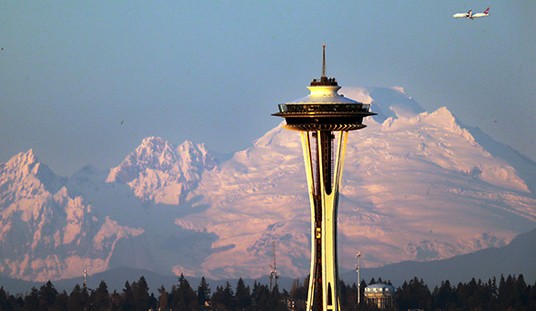It's a common aphorism when discussing our modern, technological society to point out that we stand on the shoulders of giants. This massive, connected, high-tech civilization —which, incidentally, allows me to come to you from a tiny office building out in the woods in Alaska's Susitna Valley—is a wonder, and yes, was the result of generations of development. It has made the modern world what it is, and the delivery of reliable, relatively cheap electricity to virtually everywhere in North America (and most of the rest of the world) is at its heart. The electrical grid supports not only our lighting, heating, and cooking but also our transport; even if you have a traditional gasoline-powered auto, you rely on electricity to pump that gas. And, of course, that grid supports our computers and the internet, which has ushered in the third great revolution of mankind, the first being the Agricultural Revolution, the second the Industrial Revolution, and now, we are in the throes of the Information Revolution.
And it's all balanced precariously atop a house of cards, built on a foundation of sand.
The House Oversight Committee recently hosted a discussion on the fragility of our power grid.
🚨 Rep. Pat Fallon opens hearing on examining the reliability and security of America’s electrical grid.
— Oversight Committee (@GOPoversight) March 12, 2024
“When you flip on a light switch, plug in your phone charger, or put groceries into your refrigerator, you expect electricity will be flowing.
“An elaborate network of power… pic.twitter.com/ch9J1dEGSS
“An elaborate network of power plants, transmission lines, and distribution nodes work every day to deliver electricity where and when it is needed.
“However, as the demands grow, so too do the risks for that reliability to fail.”
Yes, you expect electricity to flow, but too few people consider what will happen when it does not.
We deal with this pretty regularly here in the Great Land, as all our power lines are still on poles, above ground, and from Wasilla northward, there is one main line, which follows the Parks Highway. That's something of a bottleneck, and we have power outages several times a year, usually due to weather, usually resolved within an hour or so. The longest I remember was after a series of major windstorms when we were without power for 12 hours. That's an inconvenience, but only that, as our electrical co-op does absolutely sterling work in getting our power back on as soon as possible.
Imagine, though, what life would be like if that outage were permanent, not just here but anywhere.
There are natural events, such as solar flares, that could do great damage to the electrical grid, and at least two have happened in recorded history. The Carrington Event in 1859 disrupted telegraph operations across North America; fortunately, that was the extent of the electrical grid at that time. Another, in 1921, did damage to the nascent power grid, disrupting, among other things, railroad schedules.
In May, 1921, dazzling lights filled the night sky in places as far from the poles as Texas and Samoa; this time, too, spectacle was followed by debacle. “Electric fluid” leaping from a telegraph switchboard set on fire a railroad station in Brewster, New York, while stray voltage on railway signal and switching systems halted trains in Manhattan and, farther north, started a fire at Albany’s Union Station.
We can't control the sun, of course. But the danger from mankind may be greater, and we have already seen such acts, albeit on a local, rather than continental, scale. As simple an event as a couple of rifle bullets through a transformer can do lasting local damage, and it's already been done.
See Related: FBI Joins Investigation in Moore County, NC After Power Substations Attacked by Gunfire
The second NC Electrical Substation - This One Near Camp Lejeune - Was Attacked in November
A hostile nation-state, however, with nuclear capacity and ICBM technology, even on a 1960s level, could do far greater damage. The detonation of a nuclear warhead, or worse, several nuclear warheads, at orbital height, could cause massive damage to our electrical grid through the generation of an electromagnetic pulse (EMP.)
For a high-yield explosion of approximately 10 megatons detonated 320 km (200 miles) above the centre of the continental United States, almost the entire country, as well as parts of Mexico and Canada, would be affected by EMP—destroying practically all electronic devices and electrical transformers. Procedures to improve the ability of networks, especially military command and control systems, to withstand EMP are known as “hardening.”
It doesn't take a great deal of pondering to come up with a list of nations capable of this, and many of those nations are hostile to the United States.
Consider the implications of the destruction of much of the electrical grid.
In the event of a major attack, such as the one described above, the power would be out over most of the continental United States, as well as parts of Canada and Mexico. That outage, due to the destruction of equipment such as large power transformers (LPTs) - which, incidentally, are mostly not manufactured in the United States—may last for months, even years. And, due to the accompanying collapse in infrastructure and society, it may well be permanent.
This is an event that would plunge the United States back to the 1850s, technologically. And there's the rub: the 1850 U.S. census documented a population of a tad over 23 million people. Today, the United States has a population of over 330 million, fed by a tiny proportion of the citizenry due to modern, technologically-based farming practices and distribution networks. We're all utterly dependent on the electrical grid for everything from heat to communications. The loss of the power grid for an extended period may well plunge the American population back to the 1850 level as well; yes, that means, quite literally, the deaths of millions by starvation, civil unrest, and exposure. The delivery of medical treatment would collapse; the major cities would descend into anarchy, with most of their populations either dying or being killed outright, with survivors flooding into the countryside, desperate for food and clean water.
It is unlikely the United States or, indeed, any modern nation could recover from this.
There are efforts underway to bolster our electrical grid, but those efforts are focused not on deliberate attacks but on weather events and "climate change," with again more boondoggle spending on "green" energy with little regard to something as entirely possible as a hostile nation, say, Iran or North Korea, torching off a nuke at orbital height over St. Louis and plunging a great portion of North America into lasting darkness.
Projects funded by the federal Grid Resilience and Innovation Partnerships program will increase the flexibility, efficiency and reliability of electric power systems, with a particular focus on spurring solar, wind and other renewable energy, Granholm said. The projects also are aimed at fixing problems that may contribute to wildfires and other disasters and will improve reliability by deploying innovative approaches to electricity transmission, storage and distribution, she and other officials said.
It may be only a matter of time before this happens, and unlike many possible disasters facing the nation, there is little the ordinary American can do to prepare for this. This is a great example of a distributed interest that the government is best tasked to deal with; even a staunch minarchist like me can see the need for some action on this.
For more information, I can suggest two sources:
First, check out the 2022 film "Grid Down, Power Up." This is a chilling look at just what damage a deliberate attack could do to our electrical grid and the ramifications of such an attack. See the first look here:
Second, read William R. Forstchen's fiction novel "One Second After," for a well-researched fictional scenario of the United States following a major EMP attack on the grid.
The possibility of a deliberate attack on our power grid is horrible to contemplate. The only thing more horrible is the idea that we didn't do something about it when we could have.















